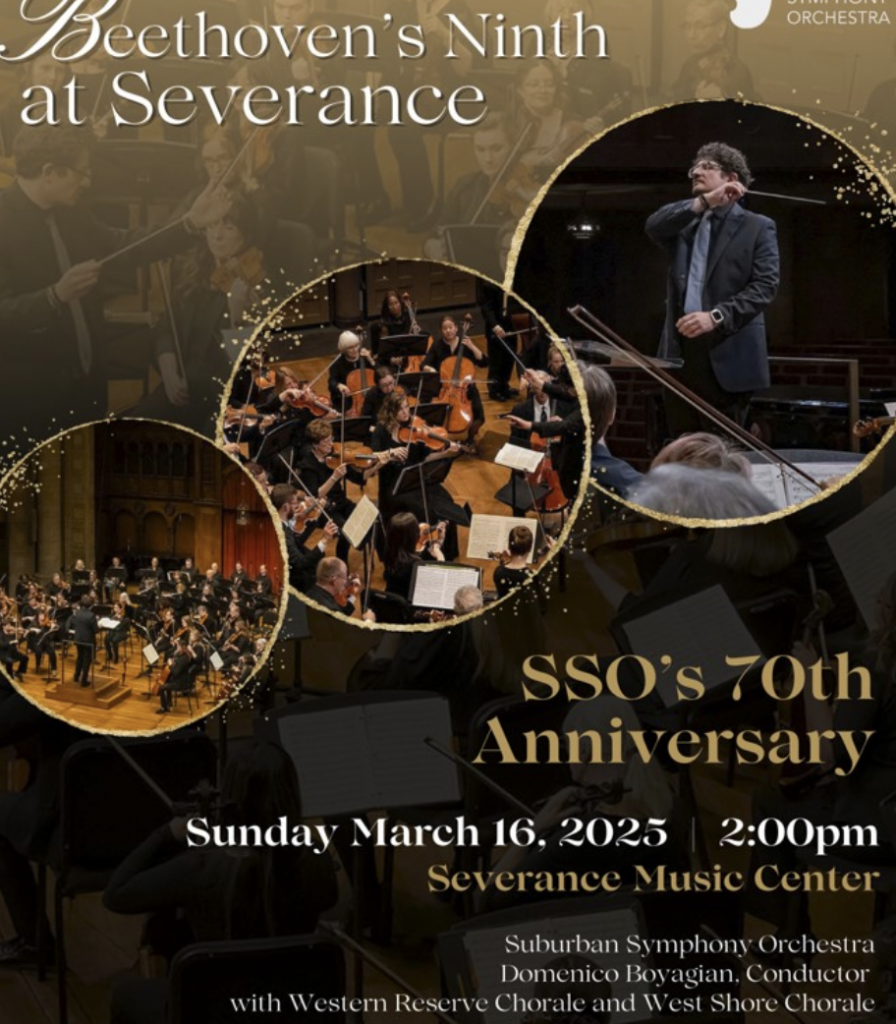by Mike Telin

On Sunday, March 16 at 2:00 pm at Severance Music Center, Domenico Boyagian will preside over “Seventy at Severance.”
The program opens with Jean Sibelius’ Karelia Suite. For the featured work, Beethoven’s Symphony No. 9, Boyagian and the Orchestra will be joined by the Western Reserve Chorale and West Shore Chorale, and soloists soprano Emily Margevich, mezzo-soprano Quinn Middleman, tenor John Pickle, and baritone Young-Kwang Yoo. WCLV’s Bill O’Connell will emcee the event. Tickets are available online.
I caught up with Domenico Boyagian on Zoom.
Mike Telin: 70 years is cause for a celebration. It’s easy to imagine why you programmed Beethoven No. 9, but how did you come to choose the Sibelius?
Domenico Boyagian: It’s a piece that we’ve wanted to do for a long time. Every once in a while we like to feature certain sections of the orchestra. In this case it’s the horns and brass.
MT: Back to Beethoven, you have two choirs and four great soloists joining you.
DB: I have worked with John Pickle, Young-Kwang Yoo, and Emily Margevich, and I have a personal connection to Quinn Middleman. These four are going to blend beautifully.
And the two choirs: there’s the West Shore Chorale directed by Michael Lisi and Western Reserve Chorale directed by David Gilson. The music directors were responsible for the preparation of their own choruses and we came together last week for the first time — they sounded wonderful.
I believe there are 150 choristers, four soloists, and at least 80 in the orchestra. So there will be around 240 people on stage.
MT: Congratulations on the anniversary. Of course you’re not responsible for all 70 years, but you did inherit an organization with a long and vibrant history.
Domenico Boyagian: That’s right. And from the beginning everyone welcomed me. At my first concert as guest conductor what really got to me was how nice they were. And believe me, I’ve conducted my share of orchestras and encountered a lot of different personalities but the Suburban Symphony, in this sense, was special.
MT: You’re only the third music director in the ensemble’s history.
DB: Yes, and it was a big responsibility to take on, and it still is. But I had a plan as far as where to take them. I believe that an orchestra is just a giant chamber music ensemble, so it did take a little bit of time to get us there. But change always takes time.
And it’s important to remember that this is not their full-time work. They go home to their families and to their jobs. But I think that we’ve gotten to a nice place.
MT: You’ve also been expanding the programming?
DB: Yes, We just did a collaboration with the Cleveland Chorale. They’re a gospel chorus and it was a great success. It was received so well by everybody, including the members of the orchestra. We’re also doing collaborations with schools, like the Student Artists from Canterbury Elementary.
And with this anniversary concert we’re working with not just one, but two choirs. These types of collaborations are what’s keeping music alive. We are not just a museum for music. We are part museum and there is nothing wrong with being a museum — museums are some of the most important cultural institutions in the world. But at the same time, every museum, even the Cleveland Museum of Art, has modern art exhibitions and talks.
We have also experimented with the format of our concerts. 75% of the time the format of every classical music concert is overture, concerto, and symphony.We stopped doing that because people expect it. And if you just expect a certain thing, you just get bored from it.
This music is alive and it should be a true representation of a little bit of the past and a little bit of the present.
MT: You don’t dumb down your programs. You’re challenging the players to step up to the plate.
DB: Absolutely. If we take on something we’ll do it well. At the same time, I like to provide support for the members. In fact our principals are professionals and we have sectional rehearsals with professional musicians.
MT: Looking at the orchestra’s website, you don’t appear to have any problems attracting musicians.
DB: We hold auditions on a regular basis, usually at the beginning of each cycle.
MT: You’ve expanded the number of players as well.
DB: I think I had four stands of first violins and four stands of second violins and now we have eight stands of firsts and eight stands of seconds. And we have eighteen cellos, and full brass and wind sections as well as enough horns to have assistants. And people stay and that’s my personal success. If you come back, it tells me that you want to come back.
MT: What is the age range of the players?
DB: We have a lot of young people including a couple of high school students. And a bunch of people in their 20s and early 30s. It’s people from all walks of life and life and all religions. It’s incredible. It’s alive because people are bringing all of their experiences and that’s exactly what a community orchestra should be.
Click here to read a brief history of the Suburban Symphony.
Published on ClevelandClassical.com March 13, 2025.
Click here for a printable copy of this article


